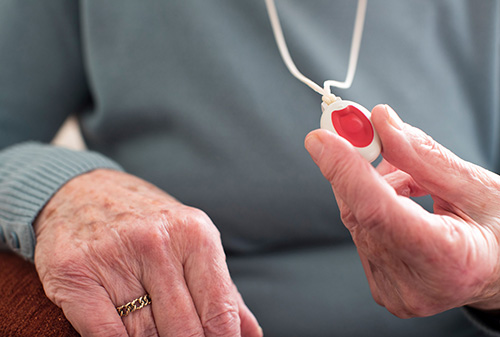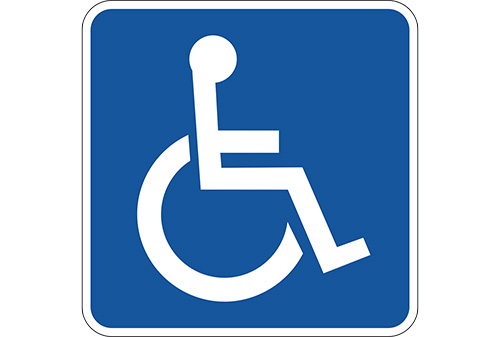




Electronic assistive technology plays a key role in promoting and protecting the individual’s well-being and rights.
One way that this can be achieved is involving the individual in the assessment of their needs and allowing them to choose appropriate electronic assistive technology that can be used to meet their needs.
Electronic assistive technology can support individuals to:
Electronic assistive technology may help carers to support an individual’s everyday activities around the house. This can help to reduce the risk of unplanned hospital admissions or permanent moves into residential care.
Positives:
Electronic assistive technology has the potential to support the independent living of people with complex disabilities in a community setting and assist carers with their work. There are a wide range of devices and services that can be integrated into the care environment which may be used in a range of applications, for example to manage risk, support self-management of chronic disease, and enable independence in the home.
The clinical application of electronic assistive technology is broad; it includes:
Positives:
The aims of electronic assistive technology may include:
Negatives:
Mae technoleg gynorthwyol electronig yn chwarae rhan allweddol yn y gwaith o hyrwyddo a diogelu llesiant a hawliau'r unigolyn.
Un ffordd y gellir cyflawni hyn yw cynnwys yr unigolyn yn yr asesiad o'i anghenion a chaniatáu iddynt ddewis technoleg gynorthwyol electronig briodol y gellir ei defnyddio i ddiwallu eu hanghenion.
Gall technoleg gynorthwyol electronig gynorthwyo unigolion i:
Gall technoleg gynorthwyol electronig helpu gofalwyr i gefnogi gweithgareddau bob dydd yr unigolyn o amgylch y tŷ. Gall hyn helpu i leihau'r risg o dderbyniadau heb eu trefnu i'r ysbyty neu symud yn barhaol i ofal preswyl.
Cadarnhaol:
Mae gan dechnoleg gynorthwyol electronig y potensial i gefnogi pobl ag anableddau cymhleth fyw'n annibynnol mewn lleoliad cymunedol a chynorthwyo gofalwyr gyda'u gwaith. Mae amrywiaeth eang o ddyfeisiau a gwasanaethau y gellir eu hintegreiddio i'r amgylchedd gofal y gellir eu defnyddio mewn ystod o gymwysiadau, er enghraifft i reoli risg, cefnogi hunanreoli clefydau cronig a galluogi annibyniaeth yn y cartref.
Mae'r defnydd clinigol o dechnoleg gynorthwyol electronig yn eang; mae’n cynnwys:
Cadarnhaol:
Gall nodau technoleg gynorthwyol electronig gynnwys:
Negyddol:

The aspirations of older or disabled people are similar to everyone else’s; they want to be seen as individuals with a range of friendships and relationships.
Most older people want to live in their own homes, they want to be independent, to be as healthy as possible and most of all, they want to be in control of their lives. They do not want others to define their limitations, however the people around the individual can become risk adverse and limit choices and experiences for fear of potential harm.
Positive risk taking acknowledges that some of the choices individuals make do have inherent risks attached, and recognises the need to minimise risk. Risk cannot be eliminated altogether.
Electronic assistive technology can support positive risk taking. By accessing electronic assistive technology, individuals and carers will feel protected and safe. Individuals will be given choices and the outcomes they want based on their needs and wants. By accessing electronic assistive technology, individuals and carers will be enabled to take measured risks promoting independence and control.
Electronic assistive technology also allows the individual to have an equal opportunity to share in the technology world.
Electronic assistive technology supports positive risk taking by:
Mae dyheadau pobl hŷn neu anabl yn debyg i ddyheadau pawb arall; maent am gael eu gweld fel unigolion sydd ag amrywiaeth o gyfeillgarwch a pherthnasau.
Mae’r rhan fwyaf o bobl hŷn am fyw yn eu cartrefi eu hunain, maent am fod yn annibynnol, i fod mor iach â phosibl ac yn bennaf oll, maent am reoli eu bywydau. Nid ydynt am i eraill ddiffinio eu cyfyngiadau, fodd bynnag gall y bobl o amgylch yr unigolyn fod yn llai parod i gymryd risigiau a gallant gyfyngu ar ddewisiadau a phrofiadau gan fod ganddynt ofn y gallant achosi niwed.
Mae cymryd risgiau cadarnhaol yn cydnabod bod rhai penderfyniadau sy’n cael ei gwneud gan yr unigolyn yn agored i risigiau cynhenid, ac yn cydnabod yr angen i leihau risg. Ni all cael gwared ar risgiau yn gyfan gwbl.
Bydd technoleg gynorthwyol electronig yn helpu i amddiffyn unigolion sy'n agored i niwed rhag niwed. Drwy ddefnyddio technoleg gynorthwyol electronig, bydd unigolion a gofalwyr yn teimlo'n ddiogel ac wedi'u diogelu. Bydd unigolion yn cael dewis, a bydd y canlyniadau y maent am eu cael ar sail eu hanghenion. Drwy ddefnyddio technoleg gynorthwyol electronig, bydd unigolion a gofalwyr yn cael eu galluogi i gymryd risgiau mesuredig er mwyn hybu annibyniaeth a rheolaeth.
Mae technoleg gynorthwyol electronig hefyd yn galluogi'r unigolyn i gael cyfle cyfartal i rannu yn y byd technoleg.
Mae technoleg gynorthwyol electronig yn cefnogi cymryd risg gadarnhaol drwy'r canlynol:

All efforts should be made to seek consent from the individual before considering the use of assistive technology as this equipment should not be considered as a separate part of an individual’s care, but integral to the care offered by professionals and part of the overall care planning process.
Whilst using electronic assistive technology has many benefits for the individual, the rights and wishes of the individual must also be considered.
Consent for the use of electronic assistive technology from the individual concerned must be obtained and respected.
Research has shown that if the individual’s views on the device selection have not been sought and considered then they will not use the technology.
Therefore, the individual being included in all decisions is vital if assistive technology is to be implemented effectively.
If the person is unable to consent to the provision of assistive technology, due to a lack of capacity, equipment may still be provided in line with the Mental Capacity Act (2005).
Dylid gwneud pob ymdrech i geisio cydsyniad yr unigolyn cyn ystyried defnyddio technoleg gynorthwyol gan na ddylid ystyried yr offer hwn yn rhan ar wahân o ofal yr unigolyn, ond yn hanfodol i'r gofal a gynigir gan weithwyr proffesiynol a rhan o'r broses gyffredinol o gynllunio gofal.
Er bod llawer o fanteision i'r unigolyn yn deillio o ddefnyddio technoleg gynorthwyol electronig, rhaid ystyried hawliau a dymuniadau'r unigolyn hefyd.
Rhaid cael caniatâd i ddefnyddio technoleg gynorthwyol electronig gan yr unigolyn dan sylw a'i barchu.
Mae ymchwil wedi dangos, os nad yw barn yr unigolyn ar y dewis o ddyfais wedi'i cheisio a'i ystyried yna ni fydd yn defnyddio'r dechnoleg.
Felly, mae cynnwys yr unigolyn ym mhob penderfyniad yn hanfodol er mwyn i dechnoleg gynorthwyol gael ei gweithredu'n effeithiol.
Os nad yw’r unigolyn yn gallu cydsynio gyda’r ddarpariaeth o dechnoleg gynorthwyol, gall offer ei ddarparu o hyd yn unol â’r Ddeddf Galluedd Meddyliol (2005).

When supporting the use of electronic assistive technology, it is important to ensure that you are respecting and promoting the dignity, autonomy, privacy and confidentiality from the individual and their caregiver.
This can be achieved by:
Supporting dignity, privacy and confidentiality
Supporting autonomy
Wrth gefnogi'r defnydd o dechnoleg gynorthwyol electronig, mae'n bwysig sicrhau eich bod yn parchu ac yn hybu urddas, ymreolaeth, preifatrwydd a chyfrinachedd yr unigolyn a'i ofalwr.
Gellir gwneud hyn trwy'r canlynol:
Cefnogi urddas, preifatrwydd a chyfrinachedd
Cefnogi ymreolaeth
Consent is particularly important when choosing to use electric assistive technology and selecting the equipment to use. The individual using the electric assistive technology must be involved in any decisions, and their consent must be sought and gained.
In some cases, this may not be possible if the individual lacks capacity to make this specific decision. In these cases, decisions need to be made in the individual’s best interests and must also be the least restrictive option.
The Mental Capacity Act (2005) sets out the law around making decisions in these situations.
When an individual is not able to express informed consent for themselves, other options need to be explored and agreed in the best interest of the individual. A best interest decision will be made, taking into account the purpose of the technology and how the individual might benefit from it. The decision makers need to ensure the following when making decisions on behalf of someone else:
Ultimately, nobody should be forced into using technology they don’t want, and technology should only be used when it’s needed. Each person’s individual needs should be considered carefully when weighing up the pros and cons of any device.
Mae caniatâd yn arbennig o bwysig wrth ddewis defnyddio technoleg gynorthwyol drydanol a dewis yr offer i'w ddefnyddio. Rhaid i'r unigolyn sy'n defnyddio'r dechnoleg gynorthwyol drydanol fod yn rhan o unrhyw benderfyniadau, a rhaid ceisio a chael ei ganiatâd.
Mewn rhai achosion, efallai na fydd hyn yn bosibl os nad oes gan yr unigolyn alluedd i wneud penderfyniadau penodol hyn. Yn yr achosion hyn, mae angen gwneud penderfyniadau er lles gorau'r unigolyn a rhaid iddo hefyd fod y dewis lleiaf cyfyngol.
Mae'r Ddeddf Galluedd Meddyliol (2005) yn nodi'r gyfraith sy'n ymwneud â gwneud penderfyniadau yn y sefyllfaoedd hyn.
Pan na fydd unigolyn yn gallu mynegi cydsyniad gwybodus ei hun, mae angen ystyried opsiynau eraill a chytuno arnynt er budd yr unigolyn. Bydd penderfyniad budd gorau i’r unigolyn yn cael ei wneud, gan ystyried pwrpas y technoleg a sut y bydd yr unigolyn yn elwa ohono. Bydd rhaid i’r rhai sy’n gwneud y penderfyniadau sicrhau’r canlynol pan fyddant yn gwneud penderfyniadau ar ran rhywun arall.
Yn y pen draw, ni ddylai neb gael ei orfodi i ddefnyddio technoleg nad ydynt ei eisiau, a dim ond pan fydd ei angen y dylid defnyddio technoleg. Dylid ystyried anghenion unigol pob unigolyn yn ofalus wrth bwyso a mesur manteision ac anfanteision unrhyw ddyfais.